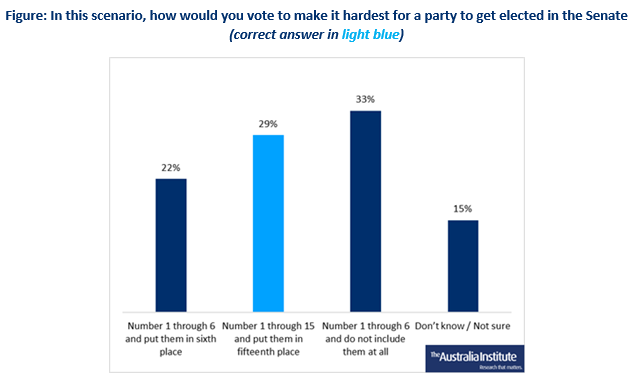Significant Proportion of Voters Uncertain on Senate Preferential Voting
The Australia Institute surveyed a nationally representative sample of 1,002 Australians about their Senate voting intentions and their understanding of how Senate voting works.
The results show:
- A significant proportion of Australians remain uncertain about important aspects of Senate preferential voting:
- More than four in ten (43%) respondents thought that putting a 6 beside a box made it harder for that party to be elected.
- One in two respondents (50%) thought that you should put a 6 beside the box of the party you dislike more than any other.
- When given an example, only three in 10 respondents (29%) were correct about how to vote in the Senate to make it hardest for a party they did not like to get elected.
- Over half (55%) chose an answer that may make it easier for a party they do not like to get elected.
- Only 31% Australians correctly answered that their Senate representatives are elected by the people living in their own state or territory.

“It is an ongoing concern that one in two Australians believe that when voting 1-6 in the Senate, that 6 ought to be beside the party you dislike more than any other, rather than your 6th most preferred choice,” said Ben Oquist, executive director of the Australia Institute.
“Put simply, to actually ‘put a party last’ on the ballot, voters must number all the boxes above the line in the order of their choice, not just six.
“We need a better public discussion about the Senate, and we need a bigger public education campaign from the AEC.
Senate Polling Research
Between 5 April and 13 May 2022, the Australia Institute conducted four surveys, surveying a total of 4,009 adults living in Australia, online through Dynata’s panel, with nationally representative samples by gender, age group and state/territory.
Voting crosstabs show voting intentions for the House of Representatives. Those who were undecided were asked which way they were leaning; these leanings are included in voting intention crosstabs. The research is compliant with the Australian Polling Council Quality Mark standards.

There are four states likely to determine the balance of power in the next Senate:
- South Australia, where the Greens Barbara Pocock is strong chance and Nick Xenophon, Rex Patrick, 3rd Labor or even One Nation are in the running.
- Tasmania, where the final seat will likely be a race between Eric Abetz and the Jacqui Lambie Network.
- Western Australia and Victoria; where Labor is in the running for three seats.
Other points of interest:
- UAP or One Nation could be in the running for final seat in Victoria.
- Amanda Stoker seems likely to lose the 3rd spot for LNP in QLD.
- Greens chance at 3 new Senators as well as re-electing current 3 up for election giving them a potential record total of 12 in the new Senate.
- There is also a possibility that independent David Pocock will displace Zed Seselja in the ACT
“Tight contests in a number of places will determine who holds or shares balance of power but one thing is clear: neither Labor or the Coalition will go anywhere near having a majority in the new Senate,” said Mr Oquist.
“Australians have two votes – their House of Representatives votes determines who forms government but their Senate vote is powerful in deciding what a government can actually do,” Oquist said.
Related research
General Enquiries
Emily Bird Office Manager
Media Enquiries
Glenn Connley Senior Media Advisor